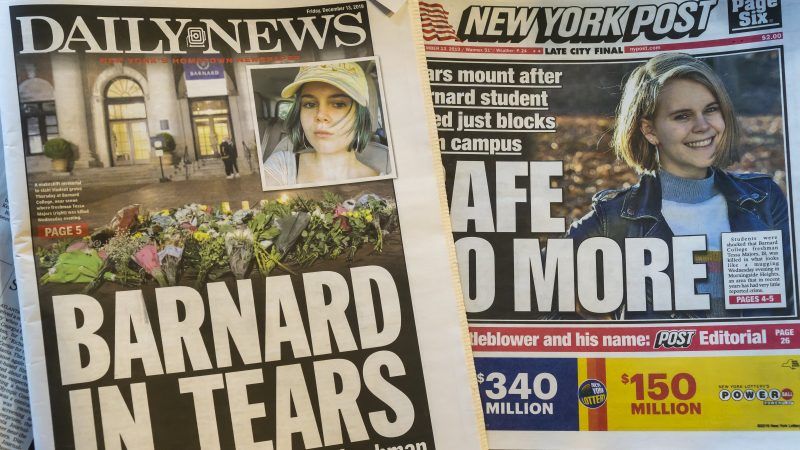Police Union Chief Claims That Lax Marijuana Enforcement Killed a College Freshman
Tessa Majors may have been on way to buy illegal pot when she was stabbed to death. But if that's true, it's an argument against prohibition, not for it.

Last week, an 18-year-old freshman student at Barnard College named Tessa Majors was stabbed to death in a Manhattan park. The New York Police Department (NYPD) believes the killer is a 13-year-old middle school student they have yet to locate. The police have talked to two other middle schoolers who were present at the crime.
Now the head of the Sergeants Benevolent Association, Ed Mullins, is attributing the death to New York's lax enforcement of marijuana prohibition. He told a radio program:
What I am understanding is that [Majors] was in the park to buy marijuana….We don't enforce marijuana laws anymore. We're basically hands-off on the enforcement of marijuana. I understand the mayor made statements that this is surprising on how this can happen in New York City….I really have to question what world he's living in to think that this is surprising, when we are watching the city slowly erode, with shootings, stabbings, an increase in homicides and, most importantly, a hands-off policing policy.
In such statements, you hear the dying echoes of what might be called the "Reefer Madness mindset," in which devil weed is the source of all forms of evil and criminality, even when it remains illegal.
New York has a medical marijuana exemption but it is still prohibited under state law to sell, buy, transport, or grow marijuana. Since 2014, the NYPD has been instructed by Mayor Bill de Blasio not to arrest most people found carrying or smoking pot, even when such use breaks "public view" laws that were routinely invoked to arrest people under the old "stop and frisk" procedures. Since August, possession of under two ounces of marijuana has been a non-criminal, ticketable offense in New York City.
The city's violent crime levels have remained basically constant in recent years. Through the end of November, the city recorded 299 homicides, up from 275 over the same period last year. Overall, the crime rate was down 1 percent compared to last year. Homicides in New York City peaked at 2,245 in 1990 and this year's rate remains on par with rates last seen in the early 1950s. New York's current population is a record high of 8.6 million.
Regardless of the legal status of pot in the Big Apple, does Sgt. Mullins seriously believe that crime and violence around marijuana would increase if it could be purchased legally, like beer, wine, and whiskey? There are still stickups and shootings at corner delis and liquor stores, but no one attributes such crimes to alcohol's legal status. A major 2017 study found that states on the border between the United States and Mexico that legalized medical marijuana saw decreases in violent crime between 5.6 percent and 12.5 percent. This fall, a study of crime in California and Washington state found that "legalizing recreational use of the drug appeared to have little to no effect on the number of violent and property crimes." A 2013 study by Rand Corporation for the Office of National Drug Control Policy concluded that "marijuana use does not induce violent crime" and "the links between marijuana use and property crime are thin."
The full story surrounding Tessa Majors brutal and senseless killing has yet to emerge—including definitive proof that she was trying to buy marijuana. But whatever details come out, it's hard to see how they will support the idea that maintaining a black market in pot sales will somehow generate less crime and violence than a legal one.


Show Comments (27)